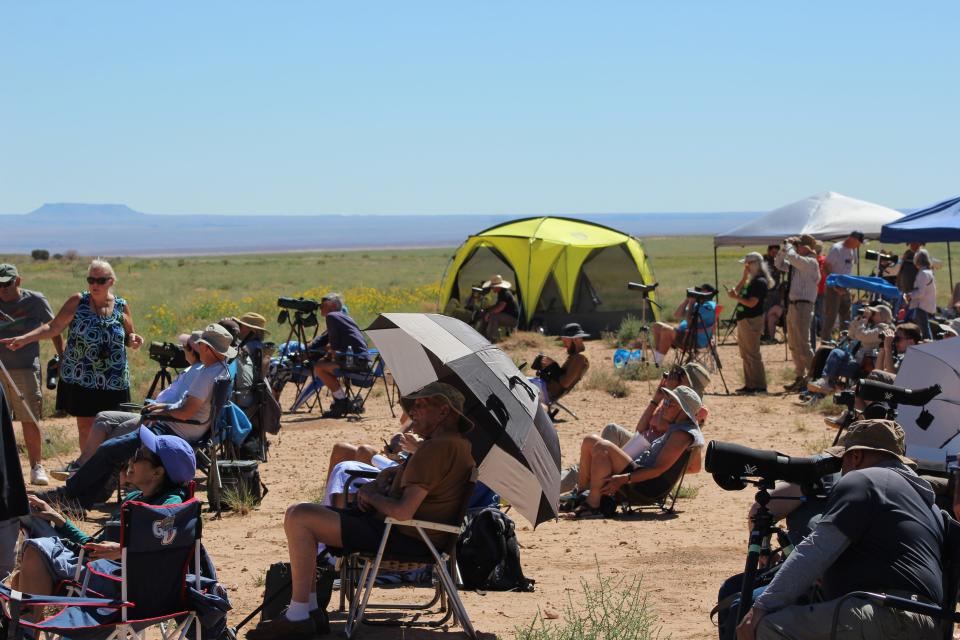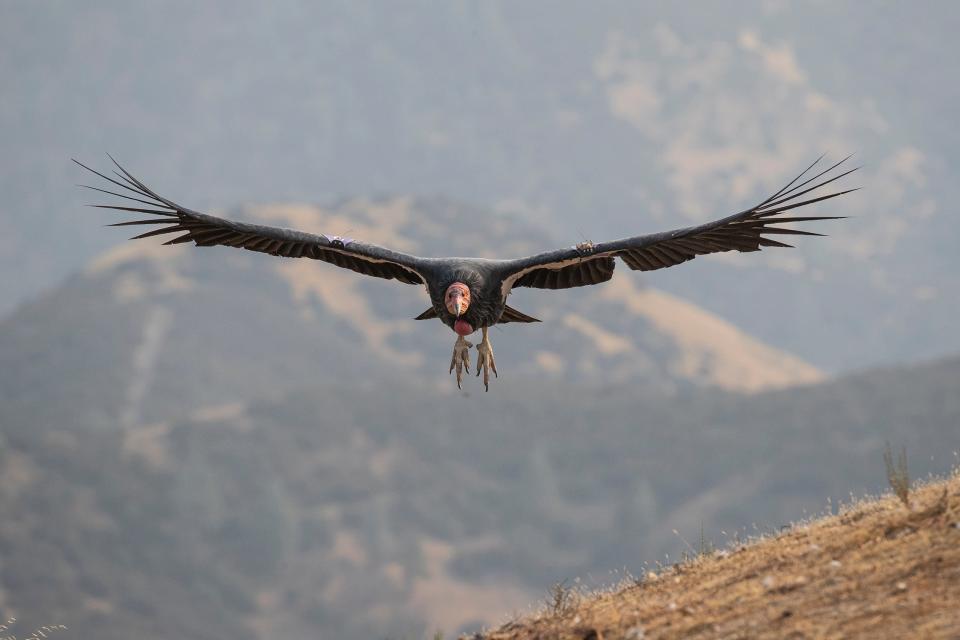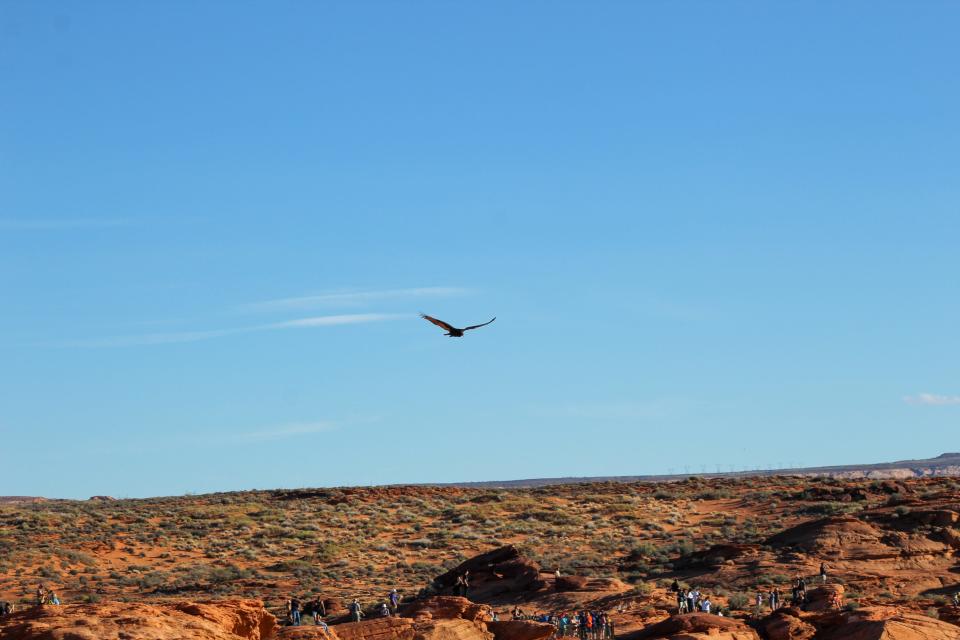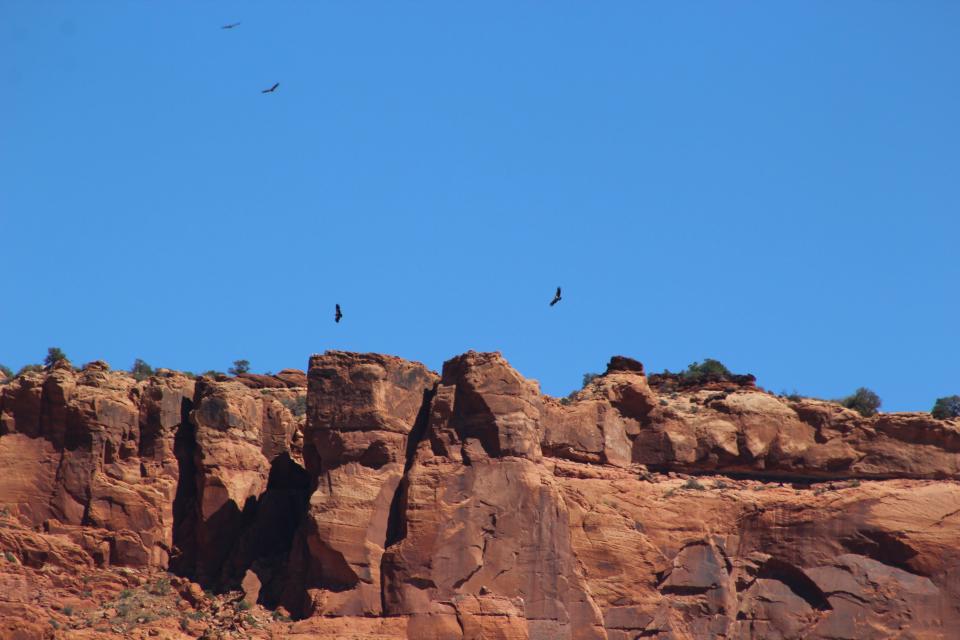Condors take flight near Grand Canyon, but lead ammo could ground the species

Chris Parrish, the CEO and president of the nonprofit Peregrine Fund, stands in front of a towering red rock backdrop. Shielded by his khaki-colored cowboy hat and wraparound sunglasses, his boots lightly dusted in Mars-like sandstone, he grips a microphone in his left hand and greets a crowd where usually there wouldn't be one.
Opposite Parrish, hundreds of eager bird watchers, conservationists and volunteers create their own gallery seating for what's to come. They sit low to the dusty ground on Tommy Bahama folding chairs, guarded by umbrellas and bucket hats to protect them from the intense September sun that beats all the way down into the canyon.

They point their telephoto lenses and viewing scopes to the top of the cliff for a chance to see the endangered California condor, a bird that disappeared from the wild and nearly went extinct. The spectators had traveled great distances for a chance to view these massive birds take off. Cars idle in a parade of vehicles leading up to the viewing site along a drawn-out dirt road, the license plates tracing them back to Oregon, Missouri, Florida.
Parrish acts as a grand marshal of sorts for what will be the 27th California condor release on the Colorado Plateau, north of the Grand Canyon.
“Here we are again,” he says, his voice projecting across the flat field at the release viewing area, about 16 miles south of the Arizona-Utah state line. “Over a quarter century of reintroducing these birds to their historic lands.”

On top of the towering red cliff, in a chain-link release pen, sit five young California condors who were bred in captivity and have never been in the wild. Three adult wild condors have taken an interest in what's happening. Social creatures by nature, the adults perch on top of the pen waiting for the new recruits to spread their wings and join the wild-and-free club.
A human joins the condors up top. Tim Hauck is the California condor reintroduction program director, and he communicates to Parish and other Peregrine Fund biologists down below via walkie-talkie.

“I think we’re ready Tim,” says Parish.
“Copy that,” Hauck’s voice is relayed down. “Here we go.”
Recovery plans established

Releases at Vermilion Cliffs National Monument began in 1995, but efforts to restore the condor’s population date back to 1975, when the first recovery plan was formed by U.S Fish and Wildlife Service.
Questions about the viability of recovery were initially raised because there were so few remaining birds in the wild.
“We had so many questions with so few birds,” Parrish said. “Will there be enough genetic diversity to see if they can have a viable population?”
Known as ‘thunderbirds,” the California condor is the largest land bird in North America. Their wingspan can exceed 9.5 feet and they can reach speeds of up to 55 mph.
A distinct-looking creature, they can be distinguished from other vultures not only by size but by a triangular white patch under their black wings.

They once soared in the thousands across the western U.S and Mexico. Fossil records indicate that the birds once inhabited areas as far east as present-day New York and Florida.
But by the mid-20th century, their range was significantly reduced as more people moved west.
“There are many theories and hypotheses as to why the birds had declined,” Parrish said. “Some say it was human encroachment. There’s that little town called Los Angles near their historic range where they were last found.”
Known as nature's cleanup crew, condors get their nutrients by feasting on dead animal carcasses, snacking on everything from beached whales to field mice. A hardy and effective immune system protects the birds from any bacteria found on the carrion.

It was the use of lead ammunition by hunters that proved deadly to many of the birds.
On impact, lead ammunition losses a portion of its weight, spreading toxic fragments along the wound channel and throughout the body of the target. Fragments of lead remain in the carcass and in the discarded guts pile. When the scavenging birds come in to feed, they ingest the lead, resulting in a fatal feast.
Ron Webb is the lead wildlife care specialist at the San Diego Zoo Safari Park. He has led the California condor program there for two years but has worked with the birds for 24 years.
He tells the story of a time-lapse photo from a field camera at a site where 31 condors could be counted in a single frame feeding off one carcass. At the time there were only 89 condors flying free in the whole state of California. Thankfully, he said, the carcass was free of lead.
“A third of the state's California condor population were feeding off this one carcass,” he said. “If that one carcass had lead in it you aren’t just affecting one bird.”
Efforts prove successful at San Diego Wild Safari Park
By 1982 only 22 California condors remained in the wild. As part of the recovery plan, biologists set out to capture all remaining birds. On Easter Sunday 1987, the final wild condor was brought in.
With no condors left in the wild, breeding programs were set up at the Los Angeles Zoo and San Diego Wild Safari Park.

Currently, there are 34 condors at the San Diego location, including chicks, release candidates (birds that will be released into the wild, like the five at the Vermilion Cliffs), and breeding pairs.
Birds are bred there, and eggs are hatched on site. After five months, about the time a bird would typically leave the nest in the wild, the young condors are moved to a facility about a mile away from the park.
“Because we have to remove them from mom and dad to make room for the next breeding season,” Webb says. “We have adult birds take over that parenting role.”
Condors typically only reproduce once every other year, which results in a slow reproduction rate for the species.
A slow reproduction rate usually is balanced out by a slow mortality rate, which would occur in nature, because condors have a lifespan of over 60 years.
“Normally that works out fine as long as the mortality rate stays at a natural rate too,” Webb said. “What caused the decline over time is that mortality rate was artificially elevated as (human) population increased in the West, and we brought guns and ammunition.”

Breeding and care specialists needed a way to increase the yield of the eggs to speed recovery efforts and combat ramped-up mortality caused by lead ammunition.
They found success in a method called double clutching, where an egg is removed from the nest to encourage the female to lay another egg.
“Double clutching is a process that would happen in the wild if the female lost her egg,” he said.
When the egg is taken from the nest, the bird experiences egg loss. Webb compares it to a miscarriage in a mammal.
“The egg acts as an embryo in the uterus,” he said. “Once that egg is lost it simulates the loss of an embryo in a mammal and she will get back in a cycle.”
About a month after the egg is removed from the nest, the cycle repeats and a new egg is laid. Early in the program, some females were triple clutched to speed up reproduction rates.
Population soars to new highs
Birds for the reintroduction program are bred at four captive breeding facilities across the West: the Los Angeles Zoo, San Diego Safari Park, the Oregon Zoo and the World Center for Birds of Prey in Boise, Idaho.

USFWS recommends where the birds will go after a year and a half at these facilities. Biologists look at representation across the entire population for the birds that are in managed care as well as which birds are living at which release sites.
Birds are given a studbook number at hatching and a tag number to help identify them in the wild. The birds will be tracked for the remainder of their life. The public can track the birds anytime as well at Condorspotter.com
Currently, the five release sites are Big Sur, Pinnacles National Park, Bitter Creek National Wildlife Refuge, all located in California, Vermillion Cliffs National Monument, as well as one release site in Baja California.
The condors are shipped from the facilities to the reintroduction location. There, the releases are watched by spectators on the ground and live streamed by thousands of bird enthusiasts around the world.
The first reintroduction occurred in 1992 in Southern California.

By 2003, condor No. 305 made history as the first California condor born in the wild post-reintroduction.
And in 2008 the project reached a milestone, for the first time more condors were flying free in the wild than remained in captivity.
Today, there are more than 500 of these massive birds living in both captivity and the wild. More than half of those are flying free over California, Arizona, Utah and Baja California.
But the biggest threat that has plagued the fate of these birds over the past century and a half, remains an issue to be confronted.
About 50 percent of all wild condor deaths recorded between 1992 and 2020 were caused by lead poisoning.
“It’s disappointing because it’s an issue that is completely controllable by humans, but it seems to be the hardest part of the program,” Webb said.
In 2019, California became the first state to ban hunting with leaded bullets. Health officials say no safe exposure levels exist for lead.
No such law banning or monitoring lead ammunition have been enacted in Utah, Arizona or Mexico.
“But there is forward progress,” Webb said. “There’s a lot of good organizations out there working with a lot of good people trying to affect change.”
'This is kind of a big deal'
Back at the foot of the cliffs, on the sunny September Saturday, Parrish praises the collaborative nature of the breeding and reintroduction program.
“All the damages we as humans do," he said. “We also do some pretty amazing things together.”

On the cliff above, Hauck supervises as one of the biologists opens the two doors on the release pen, one on top and one in the front to allow the birds the easiest way to enter their new home.
“This is kind of a big deal,” Hauck said. “This is bolstering the condor population. It goes up hopefully today by five individuals.”
Condor 1084 (5A) claps her wings and immediately takes flight once the pen doors swing open. The quick departure surprises Hauck as well as those on the ground. Sometimes the birds will sit in the pen for more than an hour after the doors open.
The remaining four birds slowly follow the first brave condor. One by one, testing the strength of their wings like a ballplayer in the on-deck circle, they take flight through the square opening and leave the cliff, like their ancestors once did without the help of humans.
Biologists from the Peregrine Fund watch from viewing scopes on the ground. Lined up in purple shirts and Fund ball caps, they will observe the birds until sundown to make sure they do not land in vulnerable areas where predation by coyotes will be a threat.

After just 31 minutes, the fifth and final bird, condor 1080 (A0) spreads his wings and enters the unknown landscape ahead. He soars with the other newest residents of the rugged canyon country, circling the cliffs and batting their black and white wings in a display of strength and resiliency.
Now 114 California Condors call this place home.
Jake Frederico covers environment issues for The Arizona Republic and azcentral. Send tips or questions to jake.frederico@arizonarepublic.com.
Environmental coverage on azcentral.com and in The Arizona Republic is supported by a grant from the Nina Mason Pulliam Charitable Trust. Follow The Republic environmental reporting team at environment.azcentral.com and @azcenvironment on Facebook, Twitter and Instagram.
Support environmental journalism in Arizona. Subscribe to azcentral today.
This article originally appeared on Arizona Republic: Condor population is recovering, but lead ammo remains a threat

